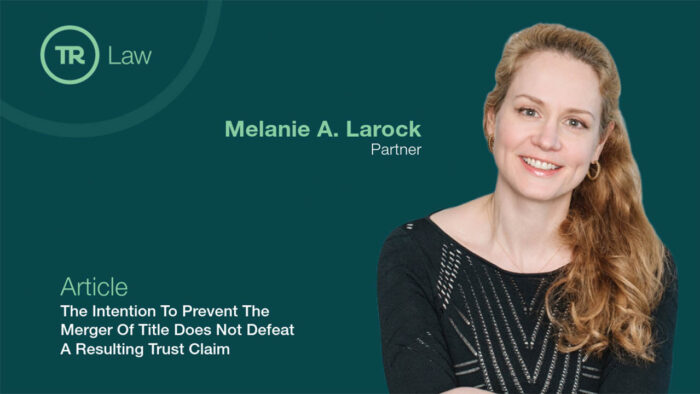Client of Thomson Rogers succeeds in long fight over weekly benefits claim at the Financial Services Commission of Ontario (FSCO)
Author(s): Stephen M. Birman
March 3, 2014
To qualify for the weekly non-earner benefit under the Statutory Accident Benefits Schedule (SABS), an insured person must meet the rigorous “complete inability to carry on a normal life” test (the “complete inability test”). Accident victims who do not work at the time of the accident (and do not qualify for an income replacement benefit) will need to satisfy this test in order to qualify for a weekly benefit. Despite the stringent test for qualification, accident victims who have seen their lives radically changed by a motor vehicle accident should not be dissuaded from pursuing these claims, though they should anticipate, and be prepared for, an aggressive defence.
I was the applicant’s counsel in the recently decided FSCO case, Bissessar v. State Farm Mutual Insurance Company – FSCO A11-000204. In the decision rendered by Arbitrator Susan Sapin on December 18, 2013, the Arbitrator found that the Applicant, Mrs. Nadira Bissessar, met the “rigorous” complete inability test almost 5 years following an April 29, 2007 motor vehicle accident, and ordered ongoing payment of benefits and the retroactive payment of the benefits plus interest from the date of the insurer’s termination of the benefit on July 15, 2009.
The complete inability test (which also applies to post 104 week caregiving benefits, where applicable) is set out in the SABS as follows:
“A person suffers a complete inability to carry on a normal life as a result of an accident if, as a result of the accident, the person sustains an impairment that continuously prevents the person from engaging in substantially all of the activities in which the person ordinarily engaged before the accident.”
Mrs. Bissessar was injured in a motor vehicle accident on April 29, 2007 (which coincidentally also happened to be her 31st birthday). At the time, she was intending to return to work from a maternity leave on the Monday following the accident.
There was no dispute that Mrs. Bissessar sustained a significant injury to her right thumb (later determined to be a dislocation of the carpal metacarpal joint) as well as soft tissue strains to her neck, upper and lower back and left knee as a result of the accident. As a result of these injuries, Mrs. Bissessar had no useful function in her right hand since the accident and had developed chronic pain, anxiety and depression which prevented her from carrying on a normal life.
Within days following the accident, Mrs. Bissessar’s mother moved into her residence with her husband and her two infant children. While the family expected the arrangement to be a temporary one, by the time of the Arbitration, Mrs. Bissessar remained unable to return to work and her mother continued to reside at the family home as the primary homemaker and caregiver for Mrs. Bissessar and her children.
Mrs. Bissessar was paid the weekly caregiving benefit up until the 104 week post accident mark. At that point the SABS required that she meet the complete inability test in order for her to continue receiving the weekly benefit. State Farm relied on reports from its assessors and took the position that she did not meet the test.
The starting point for the analysis of the complete inability test is a comparison of the insured person’s activities and life circumstances before the accident, assessed over a reasonable period, to the insured’s activities and life circumstances after the accident.
In her decision, Arbitrator Sapin compared Mrs. Bissessar’s life in the 20 months prior to the motor vehicle accident to her life following the accident. The Arbitrator found 20 months to be a reasonable period to consider for a working mother, homemaker and caregiver. Included in this 20 month period was Mrs. Bissessar’s 13 month maternity leave as well as the 7 months she worked full time prior to commencing her maternity leave.
Mrs. Bissessar testified to having had a busy life during the period before the accident. She took care of her children and, prior to her maternity leave, worked full time as a receptionist/order taker at a shipping company.
Post accident, Mrs. Bissessar was a shell of her former self, spending most of her days alone in her room sleeping or watching television. She relied on her mother to take care of the home and the children and rarely socialized with others. Her activity outside of the home was very limited.
State Farm relied on a few isolated activities, such as Mrs. Bissessar’s ability to walk her daughter to school and her occasional ability to shop with her husband, to argue that Mrs. Bissessar did not meet the complete inability test. Additionally, State Farm argued that Mrs. Bissessar was exaggerating her symptoms and was not a credible witness, going as far as to allege that she was not intending to return to work and questioning whether Mrs. Bissessar was truthful about her employment prior to her daughter’s birth.
In rejecting State Farm’s arguments, Arbitrator Sapin noted that while the threshold for qualification under the complete inability test is very high, the test should not be read so strictly as to make it virtually impossible for anyone to qualify.
The Arbitrator rejected State Farm’s attacks on Mrs. Bissessar’s credibility and specifically the claim that she exaggerated her injuries for secondary gain by finding that Mrs. Bissesssar was an unsophisticated person with little insight into her condition. The Arbitrator was also critical of attempts by State Farm to discredit the Applicant’s work record stating that:
“I find these allegations to be baseless…. If State Farm had doubts about Mrs. Bissessar’s status as a working person before the accident, it had ample time to raise them before the hearing, and, if necessary, to investigate and obtain independent evidence to contradict Mrs. Bissessar. It did not do so.”
Arbitrator Sapin accepted the opinion of Dr. Andy Cancelleire, neuropsychologist, that Mrs. Bissessar suffered from a pain disorder diagnosed as a specific form of Somatoform Disorder and that this condition best explained her disability. Despite being able to do some things, though typically with accompanying pain, Arbitrator Sapin held that Mrs. Bissessar could not genuinely “engage” in any of her pre-accident activities after the accident.
Accident victims can expect an aggressive defence when pursuing claims like Mrs. Bissessar’s because of the rigorous complete inability test and, where an applicant qualifies, the potential availability of lifetime weekly benefits. Insured’s (even those suffering from chronic pain type injuries) and their counsel should not however, be dissuaded from advancing these potentially meritorious claims where an accident victim’s life is radically altered by a motor vehicle accident.
View PDF version: ABR Updater | Issue 18 | March 2014
Share this








